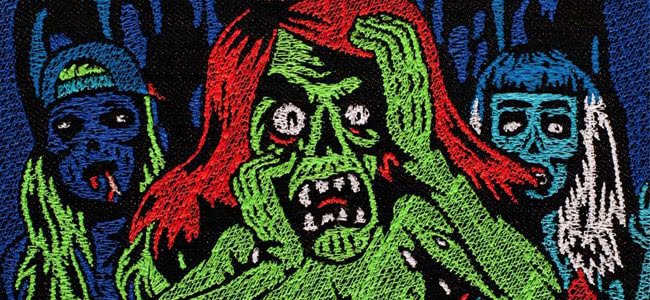London band Throne deserves a boy scout’s patch for their new sci-fi themed music video.
Not just because it’s the world’s first fully embroidered music clip, but more to credit the group’s dedication to a painstaking frame-by-frame process in bringing their awesome visual achievement to life.
While embroidery is usually the domain of knitting nanas, for the video to ‘Tharsis Sleeps’, Throne deliver a heavy metal sci-fi mini masterpiece in which the band attempt to terraform Mars with a volcano, complete with explosions, melted faces, and brain-eating zombies.
The clip look as awesome as it sounds, delivering a striking visual style composed entirely of over multi-coloured stitched canvases and stop motion animation, inspired by Throne frontman’s Nicos Livesey’s love of old school band patches. But the laborious making of the video is as hardcore as its looks are distinctive.
“I’ve always been around a lot of people who wear band patches on their jackets, so it seemed fitting,” Livesy tells Dazed about the video’s inspiration. “When I was doing the band patches, I realised it was totally animate-able – I could embroider it frame by frame and it would look mental.”
Together with animator pal Tom Bunker, the Throne singer-guitarist sewed each and every frame of ‘Tharsis Sleeps’, producing over 45 million stitches using industrial sewing machines over an estimated seven of eight months’ of work.
Love Music?
Get your daily dose of metal, rock, indie, pop, and everything else in between.
“I completely ruined any kind of social life,” Livesey says. “I haven’t spoken to anyone in the past few months. This is the most ridiculously stupid idea.”

The nearly 250 backers to a Kickstarter campaign for the video didn’t think it ‘stupid’, contributing a final tally of just shy of £8,000 (appros AU$ 14,333) towards funding the expensive project, helping to cover costs for computer animation, thread, and 250 square metres of canvas material.
[include_post id=”358792″]
“In the beginning, nothing was going right. I was like, ‘This is impossible’,’” Livesy says of the tedious process of punching out stitched canvases before scanning them digitally for animation.
“You’ve got to use this software to digitise the images into embroidery so the machines can read the image, but you’d convert it to stitch format and parts of the image would disappear randomly. I couldn’t really give up though, I was too far into it! You just have to fight through,” explains the musician.



































